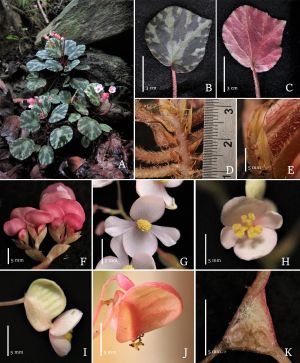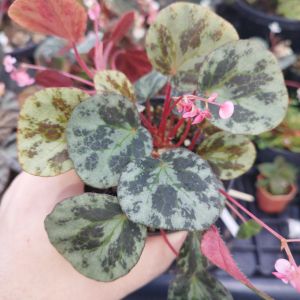Begonia beijnenii: Difference between revisions
No edit summary |
(→Photos) |
||
| (8 intermediate revisions by the same user not shown) | |||
| Line 4: | Line 4: | ||
<div class="infobox"> | <div class="infobox"> | ||
<div class="infoboximg"> | <div class="infoboximg"> | ||
[[File: | [[File:Begoniabeijnenii.jpg|thumb|center| B. beijnenii Phytotaxa]] | ||
</div> | </div> | ||
{{Infoboxsp | {{Infoboxsp | ||
| species = | | species = beijnenii | ||
| region = | | region = South East Asia | ||
| country = Philippines | | country = Philippines | ||
| year_published = 2020 | | year_published = 2020 | ||
| Line 39: | Line 39: | ||
==== References ==== | ==== References ==== | ||
[https://www.biotaxa.org/Phytotaxa/article/view/phytotaxa.455.3.2 Phytotaxa] | |||
=== Photos === | === Photos === | ||
[[File: | [[File:Begoniabeijnenii2.jpg|thumb|center|Begonia beijnenii grown in greenhouse Photo By Nathaniel Greenleaf]] | ||
[[File:Begoniabeijnenii3.jpg|thumb|center|Begonia beijnenii Another form with an interesting leaf shape Photo By Nathaniel Greenleaf]] | |||
=== External Links === | === External Links === | ||
| Line 49: | Line 51: | ||
</div> | </div> | ||
[[Category:species | [[Category:species]] | ||
[[Category:Rhizomatous]] | [[Category:Rhizomatous]] | ||
[[Category: | [[Category:South East Asia]] | ||
[[Category:Philippines]] | [[Category:Philippines]] | ||
[[Category:Baryandra]] | [[Category:Baryandra]] | ||
Latest revision as of 08:34, 13 December 2023
Species Information
Classification and Distribution
Begonia beijnenii is endemic to San Vicente, Palawan. The main population occurs on exposed limestone rocks of a waterfall in a deeply shaded forest, often seen growing along Codonoboea woodii Merr. At least two other sub-populations have been observed occurring in several disturbed areas nearby.
Habitat
The species primarily grows on exposed limestone rocks of a waterfall in a deeply shaded forest.
Characteristics
Begonia beijnenii is characterized by several distinctive features. Its rhizome is creeping, colored green to maroon, with a length of about 40 mm and a thickness of 3–4 mm. The stipules, which are pale green and triangular, remain persistent and grow to 11–14 mm in length and 4–5 mm in width. These stipules curve with age and have a keeled structure, a cuspidate apex measuring 4–5 mm, and mostly feature a smooth margin, though occasionally a single straight hair may be present near the attachment to the petiole. The leaves are alternate and have terete, maroon petioles with a length ranging from 22 to 88 mm and a thickness of 1.5–2.5 mm. Over time, the petioles elongate, becoming covered in linear white tomentose hair, especially towards the lamina. The leaf lamina is subrhomboid and succulent, appearing mostly glabrous, except for a few hairs near the petiole attachment. While most individuals exhibit dark patches on interveins and margins, some display an entirely green adaxial surface. The abaxial surface varies from pale green to maroon, with slightly raised veins featuring minute pilose hairs measuring 0.5–1 mm. The inflorescence is axillary, protandrous, and branches cymosely 3–4 times, forming a 9–14 cm long panicle. The peduncle measures 6–9.6 cm in length. Additionally, the bracts are boat-shaped with an acute apex, glabrous, and have an entire margin. The lowest bract measures 4.5 mm × 3.5 mm.
Flower Details
In terms of its floral characteristics, Begonia beijnenii exhibits staminate flowers with four pale pink, glabrous tepals. The outer tepals are orbicular with rounded apices, measuring 6.5 mm × 7.5 mm, while the inner tepals are obovate with slightly retuse apices, measuring 7 mm × 4.5 mm. The androecium comprises 28–32 stamens, with filaments measuring 1–1.5 mm and free from one another. The anthers are yellow, approximately 1 mm long, oblong-oblanceolate, with lateral slits, and the connective extends to the apex with a blunt protrusion. In contrast, the pistillate flowers also feature four pale pink, glabrous tepals. The outer tepal is orbicular with a rounded apex, measuring 6 mm × 7 mm, while the inner tepal is obovate with a slightly retuse apex, measuring 7 mm × 3.5 mm. The pistillate flowers have three styles, which are shortly fused at the base, measuring 3 mm in length, spiraled and covered with papillose hairs. The greenish-pink ovary is glabrous and trigonous-ellipsoid, measuring 6–8 mm × 2–3 mm (excluding the wings). It is adorned with three unequal wings featuring entire margins. The largest wing is lunate, distally bluntly truncated, proximally rounded, and notably cucullate, measuring approximately 4–7 mm in width. The fruit is pendent and shares similar dimensions with the ovary. It bends in such a way that the largest wing points downwards, while two lateral wings create a splash cup effect. The fruit dehisces along the attachment of the two lateral wings.
Etymology
This begonia is named after conservationist and biologist Mr. Jonah van Beijnen, who first discovered and reported about the species. It is also named in acknowledgment of his conservation efforts across Palawan, particularly his advocacy to raise The Cleopatra’s Needle Mountain Range to protected area status.
Comparison to Similar Species
Begonia beijnenii is most allied to B. hughesii, as it bears a 3-winged ovary with a cucullate wing and an abortive abaxial locule. It has tormentose petiole vestiture, glabrous adaxial leaf surface, and subglabrous abaxial leaf surface. However, Begonia beijnenii is distinctively smaller in size compared to B. hughesii.
References
Photos
External Links
Links to pages related to this species


